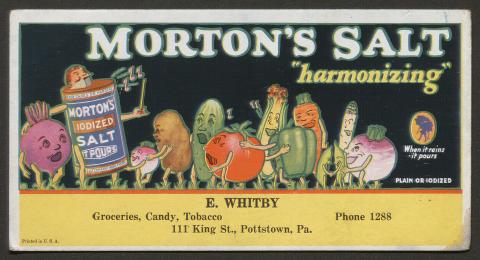
Lettuce celebrate! June 17 is Eat Your Vegetables Day, one of the cornerstone celebrations of Fresh Fruits and Vegetable Month.
Like so many mysterious internet holidays, this one has its roots in industry associations trying to get you to buy something. In this case, the source is the United Fresh Fruit and Vegetable Association, which initiated the monthlong observance in 1991.
The trade association, formed in 1937 by the merger of the Western Fruit Jobbers Association and the American Fruit and Vegetable Shippers Association, is a national trade group representing member growers, shippers, packers, processors, marketers, and distributors of fruits and vegetables in the United States.
For those of you that are blanching a bit at the idea of a veggie-based holiday, here’s a little something to help it go to down. This advertising card is one of twenty-five advertisements created by Boston’s Donnelly Advertising Company for the Morton Salt Company between around 1916 to 1923. The cards are part of Hagley Library’s Carol Litchfield collection on the history of salt (Accession 2012.219), one of the world’s greatest resources on the subject of salt
Carol Litchfield (1936-2012) earned her Doctorate in Organic Biochemistry in 1969. She was a professor at Rutgers University in the department of microbiology for ten years, until 1980 when she moved to the DuPont Company, first as head of Environmental Toxicology at Haskell Laboratory, and then as Senior Scientist for its bioremediation subsidiary.
Litchfield later started her own consulting company and worked for Chester Environmental before beginning work at George Mason University in 1993, where she remained for the rest of her career working as a professor and research professor for the Department of Biology and Department of Environmental Science and Policy.
Litchfield’s work as a biologist and biochemist specifically focused on halophilic microbiology, that being, microorganisms that live in salt rich environments. Later in her life her interest in halophiles transformed into a fascination with the history of salt. Her collection, which now resides at Hagley, covers a wide range of materials related to salt, from images of salt production and advertisements from salt companies, to salt shakers and actual pieces of salt rock, as well as Litchfield’s own personal papers, research, and work. The collection has not been digitized in its entirety, but you can view a selection of material online now in our Digital Archive. Just click here!

